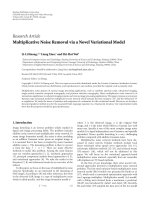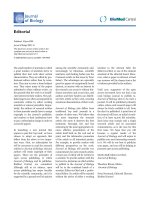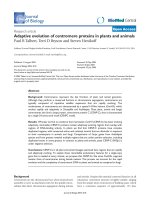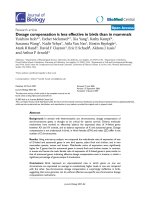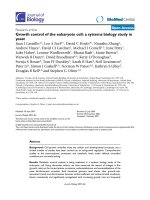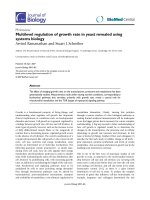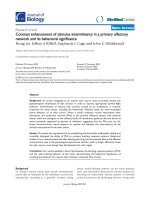Báo cáo sinh học: "Marginal inferences about variance components in a mixed linear model using Gibbs sampling" ppsx
Bạn đang xem bản rút gọn của tài liệu. Xem và tải ngay bản đầy đủ của tài liệu tại đây (880.58 KB, 22 trang )
Original
article
Marginal
inferences
about
variance
components
in
a
mixed
linear
model
using
Gibbs
sampling
CS
Wang*
JJ
Rutledge
D
Gianola
University
of
Wisconsin-Madison,
Department
of Meat
and
Animal
Science,
Madison,
WI
53706-1284,
USA
(Received
9
March
1992;
accepted
7
October
1992)
Summary -
Arguing
from
a
Bayesian
viewpoint,
Gianola
and
Foulley
(1990)
derived
a
new
method
for
estimation
of
variance
components
in
a
mixed
linear
model:
variance
estimation
from
integrated
likelihoods
(VEIL).
Inference
is
based
on
the
marginal
posterior
distri-
bution
of
each
of
the
variance
components.
Exact
analysis
requires
numerical
integration.
In
this
paper,
the
Gibbs
sampler,
a
numerical
procedure
for
generating
marginal
distri-
butions
from
conditional
distributions,
is
employed
to
obtain
marginal
inferences
about
variance
components
in
a
general
univariate
mixed
linear
model.
All
needed
conditional
posterior
distributions
are
derived.
Examples
based
on
simulated
data
sets
containing
varying
amounts
of
information
are
presented
for
a
one-way
sire
model.
Estimates
of
the
marginal
densities
of
the
variance
components
and
of
functions
thereof
are
obtained,
and
the
corresponding
distributions
are
plotted.
Numerical
results
with
a
balanced
sire
model
suggest
that
convergence
to
the
marginal
posterior
distributions
is
achieved
with
a
Gibbs
sequence
length
of
20,
and
that
Gibbs
sample
sizes
ranging
from
300 -
3 000
may
be
needed
to
appropriately
characterize
the
marginal
distributions.
variance
components
/
linear
models
/
Bayesian
methods
/
marginalization
/
Gibbs
sampler
R.ésumé -
Inférences
marginales
sur
des
composantes
de
variance
dans
un
modèle
linéaire
mixte
à
l’aide
de
l’échantillonnage
de
Gibbs.
Partant
d’un
point
de
vue
bayésien,
Gianola
et
Foulley
(1990)
ont
établi
une
nouvelle
méthode
d’estimation
des
composantes
de
variance
dans
un
modèle
linéaire
mixte:
estimation
de
variance
par
les
vraisemblances
intégrées
(VEIL).
L’inférence
est
basée
sur
la
distribution
marginale
a
posteriori
de
chacune
des
composantes
de
variance,
ce
qui
oblige
à des
intégrations
numériques
pour
arriver
aux
solutions
exactes. Dans
cet
article,
l’échantillonnage
de
Gibbs,
qui
est
une
procédure
numérique
pour
générer
des
distributions
marginales
à
partir
de
distributions
*
Correspondence
and
reprints.
Present
address:
Department
of
Animal
Science,
Cornell
University,
Ithaca,
NY
14853,
USA
conditionnelles,
est
employé
pour
obtenir
des
inférences
marginales
sur
des
composantes
de
variance
dans
un
modèle
linéaire
mixte
univarié
général.
Toutes
les
distributions
conditionnelles
a
posteriori
nécessaires
sont
établies.
Des
exempdes
basés
sur
des
données
simulées
contenant
plus
ou
moins
d’information
sont
présentés
pour
un
modèle
paternel
à
un
facteur.
Des
estimées
des
densités
marginales
des
composantes
de
variance
et
de
fonctions
de
celles-ci
sont
obtenues,
et
les
distributions
correspondantes
sont
tracées. Les
résultats
numériques
avec
un
modèle
paternel
équilibré
suggèrent
que
la
convergence
vers
les
distributions
marginales
a
posteriori
est
atteinte
avec
une
séquence
de
Gibbs
longue
de
20
unités,
et
que
des
tailles
de
l’échantillon
de
Gibbs
allant
de
300
à
3 000
peuvent
être
nécessaires
pour
caractériser
convenablement
les
distributions
marginales.
composante
de
variance
/
modèle
linéaire
/
méthode
bayésienne
/
marginalisation
/
échantillonnage
de
Gibbs
INTRODUCTION
Variance
components
and
functions
thereof
are
important
in
quantitative
genetics
and
other
areas
of
statistical
inquiry.
Henderson’s
method
3
(Henderson,
1953)
for
estimating
variance
components
was
widely
used
until
the
late
1970’s.
With
rapid
advances
in
computing
technology,
likelihood
based
methods
gained
favor
in
animal
breeding.
Especially
favored
has
been
restricted
maximum
likelihood
under
normality,
known
as
REML
(Thompson,
1962;
Patterson
and
Thompson,
1971).
This
method
accounts
for
the
degrees
of
freedom
used
in
estimating
fixed
effects,
which
full
maximum
likelihood
(ML)
does
not
do.
ML
estimates
are
obtained
by
maximizing
the
full
likelihood,
including
its
loca-
tion
variant
part,
while
REML
estimation
is
based
on
maximizing
the
&dquo;restricted&dquo;
likelihood,
ie,
that
part
of
the
likelihood
function
independent
of
fixed
effects.
From
a
Bayesian
viewpoint,
REML
estimates
are
the
elements
of
the
mode
of
the
joint
posterior
density
of
all
variance
components
when
flat
priors
are
employed
for
all
parameters
in
the
model
(Harville,
1974).
In
REML,
fixed
effects
are
viewed
as
nui-
sance
parameters
and
are
integrated
out
from
the
posterior
density
of
fixed
effects
and
variance
components,
which
is
proportional
to
the
full
likelihood
in
this
case.
There
are
at
least
2
potential
shortcomings
of REML
(Gianola
and
Foulley,1990).
First,
REML
estimates
are
the
elements
of
the
modal
vector
of
the
joint
posterior
distribution
of
the
variance
components.
From
a
decision
theoretic
point
of
view,
the
optimum
Bayes
decision
rule
under
quadratic
loss
in
the
posterior
mean
rather
than
the
posterior
mode.
The
mode
of
the
marginal
distribution
of
each
variance
component
should
provide
a
better
approximation
to
the
mean
than
a
component
of
the
joint
mode.
Second,
if
inferences
about
a
single
variance
component
are
desired,
the
marginal
distribution
of
this
component
should
be
used
instead
of
the
joint
distribution
of
all
components.
Gianola
and
Foulley
(1990)
proposed
a
new
method
that
attempts
to
satisfy
these
considerations
from
a
Bayesian
perspective.
Given
the
prior
distributions
and
the
likelihood
which
generates
the
data,
the
joint
posterior
distribution
of
all
parameters
is
constructed.
The
marginal
distribution
of
an
individual
variance
component
is
obtained
by
integrating
out
all
other
parameters
contained
in
the
model.
Summary
statistics,
such
as
the
mean,
mode,
median and
variance
can
then
be
obtained
from
the
marginal
posterior
distribution.
Probability
statements
about
a
parameter
can
be
made,
and
Bayesian
confidence
intervals
can
be
constructed,
thus
providing
a
full
Bayesian
solution
to
the
variance
component
estimation
problem.
In
practice,
however,
this
integration
cannot
be
done
analytically,
and
one
must
resort
to
numerical
methods.
Approximations
to
the
marginal
distributions
were
proposed
(Gianola
and
Foulley,
1990),
but
the
conditions
required
are
often
not
met
in
data
sets
of
small
to
moderate
size.
Hence,
exact
inference
by
numerical
means
is
highly
desirable.
Gibbs
sampling
(Geman
and
Geman,
1984)
is
a
numerical
integration
method.
It
is
based
on
all
possible
conditional
posterior
distributions,
ie,
the
posterior
distribution
of
each
parameter
given
the
data
and
all
other
parameters
in
the
model.
The
method
generates
random
drawings
from
the
marginal
posterior
distributions
through
iteratively
sampling
from
the
conditional
posterior
distributions.
Gelfand
and
Smith
(1990)
studied
properties
of
the
Gibbs
sampler,
and
revealed
its
potential
in
statistics
as
a
general
numerical
integration
tool.
In
a
subsequent
paper
(Gelfand
et
al,
1990),
a
number
of applications
of
the
Gibbs
sampler
were
described,
including
a
variance
component
problem
for
a
one-way
random
effects
model.
The
objective
of
this
paper
is
to
extend
the
Gibbs
sampling
scheme
to
variance
component
estimation
in
a
more
general
univariate
mixed
linear
model.
We
first
specify
the
Gibbs
sampler
in
this
setting
and
then
use
a
sire
model
to
illustrate
the
method
in
detail,
employing
7
simulated
data
sets
that
encompass
a
range
of
parameter
values.
We
also
provide
estimates
of
the
posterior
densities
of
variance
components
and
of
functions
thereof,
such
as
intraclass
correlations
and
variance
ratios.
SETTING
Model
Details
of
the
model
and
definitions
are
found
in
Macedo
and
Gianola
(1987),
Gianola
et
al
(1990a,
b)
and
Gianola
and
Foulley
(1990);
only
a
summary
is
given
here.
Consider
the
univariate
mixed
linear
model:
where:
y:
data
vector
of
order n
x 1;
X:
known
incidence
matrix
of
order
n
x
p;
Zi:
known
matrix
of
order
n
x
qi;
p:
p
x
1
vector
of
uniquely
defined
&dquo;fixed
effects&dquo;
(so
that
X
has
full
column
rank);
ui
: q
i
x
1
&dquo;random&dquo;
vector;
and
ei:
n
x
1
vector
of
random
residuals.
The
conditional
distribution
which
generates
the
data
is.
where
R
is
an n
x
n
known
matrix,
assumed
to
be
an
identity
matrix
here,
and
Qe
2
is
the
variance
of
the
random
residuals.
Prior
distributions
Prior
distributions
are
needed
to
complete
the
Bayesian
specification
of
the
model.
Usually,
a
&dquo;flat&dquo;
prior
distribution
is
assigned
to
J3,
so
as
to
represent
lack
of
prior
knowledge
about
this
vector,
so:
where
Gi
is
a
known
matrix
and
a’
.
is
the
variance
of
the
prior
distribution
of
ui.
All
ui
’s
are
assumed
to
be
mutually
independent,
a
priori,
as
well
as
independent
of p.
Independent
scaled
inverted
x2
distributions
are
used
as
priors
for
variance
components,
so
that:
Above
ve
(v
u; )
is
a
&dquo;degree
of
belief&dquo;
parameter,
and
se (su
a
)
can
be
interpreted
as
a
prior
value
of
the
appropriate
variance.
In
this
paper,
as
in
Gelfand
et
al
(1990)
we
assume
the
degree
of
belief
parameters,
ve
and
v!;,
to
be
zero
to
obtain
the
&dquo;naive&dquo;
ignorance
improper
priors:
The
joint
prior
density
offi,u
i
(i
=
1, 2, , c),
U2i
(i
=
1, 2, , c)
and
Qe
is
the
product
of
densities
associated
with
(3-7J,
realizing
that
there
are
c
random
effects,
each
with
their
respective
variances.
The
joint
posterior
distribution
resulting
from
priors
[7]
is
improper
mathemati-
cally,
in
the
sense
that
it
does
not
integrate
to
1.
The
improperty
is
due
to
(6J,
and
it
occurs
at
the
tails.
Numerical
difficulties
can
arise
when
a
variance
component
has
a
posterior
distribution
with
appreciable
density
near
O.
In
this
study,
priors
[7]
were
employed
following
Gelfand
et
al
(1990),
and
difficulties
were
not
encountered.
However,
informative
or
non
informative
priors
other
than
[7]
should
be
used
T
in
applications
where
it
is
postulated
that
at
least
one
of
the
variance
components
is
close
to
O.
JOINT
AND
FULL
CONDITIONAL
POSTERIOR
DISTRIBUTIONS
Denote
u’
=
ui, ,
u!)
and
v’ =
(Q!1, ,
Qu!).
Let
f
= (u! ,u!_i,u!i, ,u!)
and v’ _ (a2 ’ !2 !z . !2 )
be u’
’
U-i
=
-
U1&dquo;&dquo;,Ui-1,Ui+1&dquo;&dquo;’Uc
c
an
y-i
=
aU1&dquo; ,aU’-1,aUH1&dquo; ,auc
v.!
e
U
and
yf
with
the
ith
element
deleted
from
the
set.
The
joint
posterior
distribution
of
the
unknowns
(fi, u,
y
and
ud)
is
proportional
to
the
product
of
the
likelihood
function
and
the
joint
prior
distribution.
As
shown
by
Macedo
and
Gianola
(1987)
and
Gianola
et
al
(1990a,
b),
the
joint
posterior
density
is
in
the
normal-gamma
form:
The
full
conditional
density
of
each
of
the
unknowns
is
obtained
by
regarding
all
other
parameters
in
[8]
as
known.
We
then
have:
Manipulating
[9]
leads
to
I
1
where
p
=
(X’X)-’X’(y -
L
Ziui
).
Note
that
this
distribution
does
not
depend
i=l
i
on
u2 - -
on
Q
u
The
full
conditional
distribution
of
each
ui
(i
=
1,
2, ,
c)
is
multivariate
normal:
The
full
conditional
density
of
Qe
is
in
the
scaled
inverted
X2
form:
c
c
with
parameters
ve
= n
and sd
=
(y-Xfi- L
Ziui)’(y-X!-! Ziui)/n.
Each
:
=i
:=i
full
conditional
density
of
a!,
also
is
in
the
scaled
inverted
X2
form:
with
parameters
v
u;
=
qi
and
s2
=
u!G71 t . ui/qi.
The
full
conditional
distributions
[9-12]
are
essential
for
implementing
the
Gibbs
sampling
scheme.
OBTAINING
THE
MARGINAL
DISTRIBUTIONS
USING
GIBBS
SAMPLING
Gibbs
sampling
In
many
Bayesian
problems,
marginal
distributions
are
often
needed
to
make
ap-
propriate
inferences.
However,
due
to
the
complexity
of
joint
posterior
distributions
obtaining
a
high degree
of
marginalization
of
the
joint
posterior
density
is
difficult
or
impossible
by
analytical
means.
This
is
so
for
many
practical
problems,
eg
infer-
ences
about
variance
components.
Numerical
integration
techniques
must
be
used
to
obtain
the
exact
marginal
distributions,
from
which
functions
of
interest
can
be
computed
and
inferences
made.
A
numerical
integration
scheme
known
as
Gibbs
sampling
(Geman
and
Geman,
1984;
Gelfand
and
Smith,
1990;
Gelfand
et
al,
1990;
Casella
and
George,
1990)
circumvents
the
analytical
problem.
The
Gibbs
sampler
generates
a
random
sample
from
a
marginal
distribution
by
successively
sampling
from
the
full
conditional
distributions
of
the
random
variables
involved
in
the
model.
The
full
conditional
distribution
presented
in
the
previous
sections
are
summarized
below:
Although
we
are
interested
in
the
marginal
distributions
of
Qe
and
a Ui 2
only,
all
full
conditional
distributions
are
needed
to
implement
the
sampler.
The
ordering
placed
above
is
arbitrary.
Gibbs
sampling
proceeds
as
follows:
(i)
set
arbitrary
initial
values
for
p,
u,
v,
U2
(ii)
generate
ud
from
(13J,
and
update
U2
;
e
(iii)
generate
a2i u
from
(14J,
and
update
O-u
2i
(iv)
generate
ui
from
(15J,
and
update
ui
;
(v)
generate
f3
from
(16J,
and
update 13;
and
(vi)
repeat
(ii-v)
k
times,
using
the
updated
values.
We
call k
the
length
of
the
Gibbs
sequence,
Ask -
oo,
the
points
from
the
kth
iteration
are
sample
points
from
the
appropriate
marginal
distributions.
The
convergence
of
the
samples
from
the
above
iteration
scheme
to
drawings
from
the
marginal
distributions
was
established
by
Geman
and
Geman
(1984)
and
restated
by
Gelfand
and
Smith
(1990)
and
Tierney
(1991).
It
should
be
noted
that
there
are
no
approximations
involved.
Let
the
sample
points
be:
( 2) (k) ( 2 ) (k)
(i
=
1, 2
, ,
c
),
(
ui)(
k)
(i
-
1, 2, , c)
and
(f3)
lk
>
respectively,
where
superscript
(k)
denotes
the
kth
iteration.
Then:
(vii)
Repeat
(i-vi)
m
times,
to
generate
m
Gibbs
samples.
At
this
point
we
have:
Because
our
interest
is
in
making
inferences
about
o,
and
Q
u.,
no
attention
will
be
paid
hereafter
to
ui
and
P.
However,
it
is
clear
that
the
marginal
distributions
of
ui
and P
are
also
obtained
as
a
byproduct
of
Gibbs
sampling.
Density
estimation
After
samples
from
the
marginal
distributions
are
generated,
one can
estimate
the
densities
using
these
samples
and
the
full
conditional
densities.
As
noted
by
Casella
and
George
(1990)
and
Gelfand
and
Smith
(1990),
the
marginal
density
of
a
random
variable
x
can
be
written
as:
An
estimator
of
p(!)
is:
Thus,
the
estimator
of
the
marginal
density
of
Qe
is:
The
estimated
values of
the
density
are
thus
obtained
by
fixing
Qe
(at
a
number
of
points
over
its
space),
and
then
evaluating
[21]
at
each
point.
Similarly,
the
estimator
of
the
marginal
density
of
Qui
is:
Additional
discussion
about
mixture
density
estimators
is
found
in
Gelfand
and
Smith
(1990).
Estimation
of
the
density
of
a
function
of
the
variance
components
is
accom-
plished
by
applying
theory
of
transformations
of
random
variables
to
the
estimated
densities,
with
minimal
additional
calculations.
Examples
of
estimating
the
densi-
ties
of
variance
ratios
and
of
an
intraclass
correlation
are
given
later.
APPLICATION
OF
GIBBS
SAMPLING
TO
THE
ONE-WAY
CLASSIFICATION
Model
We
consider
the
one-way
linear
model:
where
(3
is
a
&dquo;fixed&dquo;
effect
common
to
all
observations,
ui
could
be,
for
example,
sire
effects,
and
e
ij
is
a
residual
associated
with
the record
on
the
jth
progeny
of
sire
i.
It
is
assumed
that:
where
NiD
and
NiiD
stand
for
&dquo;normal,
independently
distributed&dquo;
and
&dquo;normal,
independently
and
identically
distributed&dquo; ,
respectively.
Conditional
distributions
For
this
model,
the
parameters
of
the
normal
conditional
distribution
of ,6Iu,
Qu,
<7!, y
in
[9]
are:
Likewise,
the
parameters
of
the
normal
conditional
distribution
of
ul,8,
au 2
,ae 2
y
in
[10]
are:
with
a
=
a;/a!,
and
the
covariance
matrix
is:
with
c
ii
=
1/(n;.
+
a).
Because
the
covariance
matrix
is
diagonal,
each
ui
can
be
generated
independently
as:
The
conditional
density
of
a;
in
!11!
can
be
written
as:
Because
e e
XN
,
it
follows
that
ud -
Ns!x&dquo;i/,
so
[31]
is
the
kernel of
a
multiple
of
an
inverted
XZ
random
variable.
Finally,
the
conditional
density
of
ufl
in
[12]
is
expressible
as:
Since
q
s2/
0
,2
_
X2
,
then
0
,2 -
q S!X;2,
also
a
multiple
of
an
inverted
X2
variable.
Data
sets
and
designs
Seven
data
sets
(experiments)
were
simulated,
so
as
to
represent
situations
that
differ
in
the
amount
of
statistical
information.
Essentials
of
the
experimental
designs
are
in
table
1.
Number
of
sire
families
(q)
varied
from
10
to
10
000,
while
number
of
progeny
per
family
(n)
ranged
from
5
to
20.
The
smallest
experiment
was
I,
with
10
sires
and
5
progeny
per
sire;
the
largest
one
was
VII,
with
a
total
of
100 000
records.
Only
balanced
designs
(n
i
=
n,
for
i
=
1, 2, ,
q)
were
reported
here,
as
similar
results
were
found
with
unbalanced
layouts.
Data
were
randomly
generated
using
parameter
values
of
0 and
1
for
(3
and
a!,
respectively.
Parametric
values
for
a;
were
from
1
to
99,
thus
yielding
intraclass
correlations
(p)
ranging
from
0.01
to
0.5.
From
a
genetic
point
of
view,
an
intraclass
correlation
of
0.5
(Data
set
I)
is
not
possible
in
a
sire
model,
but
it
is
reported
here
for
completeness.
The
Gibbs
sampler
[13-16]
was
run
at
varying
lengths
of
the
Gibbs
sequence
(k
=
10
to
100)
and
Gibbs
sample
sizes
(m
=
300
to
3 000),
to
assess
the
effects
of
k
and
m
on
the
estimated
marginal
distributions.
FORTRAN
subroutines
of
the
IMSL
(IMSL
Inc,
1989)
were
used
to
generate
normal
and
inverted
X2
random
deviates.
At
the
end
of
each
run,
the
following
quantities
were
retained:
Sample
points
in
[37]
and
(38),
are
needed
for
density
estimation,
as
noted
below.
Marginal
density
estimation
The
estimators
of
the
marginal
densities
of
or2and
<7!
were:
Using
the
theory
of
transformation
of
random
variables,
we
obtained
the
marginal
density
of
the
variance
ratio y
=
a!/a;
by
fixing
a;,
using
[40]
as:
If
inferences
are
to
be
made
about
the
intraclass
correlation
p
=
ufl /(ufl
+
a;),
the
Jacobian
of
the
transformation
from ,
to
p
is J
=
!e/(1 -
p)
2,
so
from
!40!,
considering
a;
as
fixed,
the
marginal
density
of
the
intraclass
correlation
is:
Densities
of
any
functions
of
the
variance
components
can
be
estimated
in
a
similar
manner.
Density
[39]
can
also
be
used
to
make
the
transformations.
Note
that
the
Gibbs
sampler
[13-16]
does
not
need
to
be
run
again
to
obtain
the
densities
of
the
functions
of
variance
components.
Plots
were
generated
using
densities
[39-42]
by
selecting
50
to
100
equally
spaced
points
in
the
&dquo;effective&dquo;
range
of
the
variables;
the
&dquo;effective&dquo;
range
of
the
variable
covers
at
least
99.5%
of
the
density
mass.
Summary
statistics
of
the
posterior
distributions
such
as
mean,
mode,
median
and
variance
were
calculated
using
the
composite
Simpson’s
rules
of
numerical
integration
by
dividing
the
effective
range
of
the
variables
into
100
to
200
equally
spaced
intervals.
Where
appropriate,
summary
statistics
were
calculated
using
the
densities
estimated
at
higher
values
of
m
or
k.
RESULTS
The
estimated
marginal
densities
of
variance
components
and
of
their
functions
(q
and
p)
are
depicted
in
figures
1
to
7,
in
which
solid
curves
correspond
to
densities
estimated
at
higher
values
of
m
or k
and
vice
versa
for
the
dotted
ones.
These
figures
correspond
to
the
7
designs
given
in
table
I.
Figure
1
represents
a
situation
where
50%
of
the
total
variance
is
&dquo;due
to
sires&dquo;,
ie,
a
high
intraclass
correlation;
as
noted
earlier,
this
is
not
possible
genetically.
All
posterior
distributions
were
unimodal,
and
convergence
of
the
Gibbs
sampling
scheme
to
the
appropriate
marginals
was
achieved
with
k
=
20
and k
=
300,
as
it
can
be
ascertained
from
direct
inspection
of
the
curves.
Because
of
the
limited
information
contained
in
data
set
I(q
= 10,
n
=
5),
posterior
densities
were
not
symmetric,
so
the
mean,
mode
and
median
differ.
The
median
was
closer
to
the
true
values
of
the
parameters
than
the
mean
and
the
mode;
this
was
true
for
all
4
distributions
considered.
For data
sets
II-IV,
with
heritabilities
ranging
from
20-80%,
and
number
of
sires
from
50
to
1000,
the
posterior
densities
(figs
2-4)
were
nearly
symmetric,
so
the
3
location
statistics
were
very
similar
to
each
other.
In
figure
4,
corresponding
to
a! = 1,
Qe
=
10
and
to
a
data
set
with
1000
sires
and
a
total
of
20 000
records,
the
posterior
coefficients
of
variation
were
approximately
1%
for
or
and
9%
for
the
remaining
parameters.
This
illustrates
the
well
known
result
that
Qe
is
less
difficult
to
estimate
than
or
or
functions
thereof.
The
plots
suggest
convergence
of
the
Gibbs
sampler
at
values
of
k
as
low
as
10-20.
Some
difficulties
were
encountered
with
the
Gibbs
sampling
schemes
in
designs
V
and
VI
(fig
5
and
6,
respectively).
These
designs
correspond
to
situations
of
low
heritability
and
of
mild
information
about
parameters
contained
in
the
data.
While
there
was
no
problem
in
general
with
the
posterior
distribution
of
Q
e,
this
was
not
so
for
the
remaining
3
parameters.
Typical
problems
were
bi-modality
or
lack
of
smoothness
in
the
left
tail
of
the
estimated
densities.
These
were
found
to
be
related
to
insufficient
Gibbs
sample
size,
and
were
corrected
by
increasing
the
Gibbs
sampling
size
(m).
Compare,
for
example,
the
dotted
(m
=
300)
with
the
solid
(m
=
3 000)
curves
in
figure
6.
A
more
awkward
distribution
requires
more
samples
to
be
characterized
accurately.
Recall
that
each
of
the
density
estimators
[40]-[42]
was
obtained
by
averaging
m
conditional
densities.
In
the
case
of
badly
behaved
marginal
distributions,
which
are
associated
with
low
heritability
and
small
data
sets,
it
is
possible
to
obtain
&dquo;outlier
conditional
densities&dquo;.
The
outliers
can
be
influential
and
distort
the
values
of
the
estimated
density
unless
m
is
large
enough.
It
is
clear
from
the
figures
that
smooth
posterior
estimated
densities
for
awkward
distributions,
eg,
for
heritability
as
low
as
4%,
can
be
obtained
by
increasing
Gibbs
sample
size,
albeit
at
computational
expense.
At
this
level
of
heritability,
when
the
number
of
sire
families
was
increased
to
10 000,
posterior
distributions
were
nearly
symmetric
(fig
7),
and
there
was
little
variability
about
the
parametric
values.
Gianola
and
Foulley
(1990)
gave
approximations
to
the
marginal
distribution
of
variance
components,
which
should
be
adequate
provided
that
the
joint
posterior
density
of
the
ratios
between
variance
components
is
sharp
or
symmetric
about
its
mode.
As
in
any
approximation,
its
goodness
depends
on
the
amount
of
information
contained
in
the
data,
and
on
the
number
of
parameters
in
the
model.
An
important
practical
question
is
to
what
extent
the
approximations
hold.
From
our
experiments,
the
information
in
data
sets
I,
II,
V
and
VI
is
not
sufficient
to
justify
use
of
the
approximation,
even
in
a
model
with
2
variance
components;
this
is
so
because
the
marginal
distribution
of
the
variance
ratio
was
neither
sharp
nor
symmetric.
However,
the
approximation
would
hold
in
the
remaining
data
sets.
A
more
detailed
comparative
study
between
the
exact
and
the
approximate
method
is
needed
to
ascertain
when
the
latter
can
be
used
confidently.
In
the
meantime,
the
Gibbs
sampling
provides
a
way
to
estimate
the
marginal
distributions
without
using
complicated
numerical
integration
procedures.
The
present
work
is
an
extension
of
that
of
Gelfand
et
al
(1990),
in
which
they
illustrated
the
Gibbs
sampler
with
several
normal
data
models,
including
variance
component
estimation
in
a
balanced
one-way
random
effects
layout.
In
our
paper,
formulae
were
presented
to
implement
Gibbs
sampling
in
a
more
general
univariate
mixed
linear
model.
With
these
extensions,
a
full
Bayesian
solution
to
the
problem
of
inference
about
variance
components,
and
functions
thereof
in
such
a
mixed
linear
model
is
possible.
Gibbs
sampling
turns
an
analytically
intractable
multidimensional
integration
problem
into
a
feasible
numerical
one.
Gibbs
sampling
is
relatively
easy
to
implement.
Given
the
likelihood
function
and
the
priors,
one
can
always
obtain the
joint
posterior
density
of
the
unknowns
under
consideration.
From
this
density,
at
least
in
the
normal
linear
model,
one can
directly
get
the
full
conditional
distribution
of
a
particular
variable
by
fixing
the
rest
of
the
variables
in
the
joint
posterior
distribution.
The
set
of
all
full
conditional
densities
gives
the
expressions
needed
for
implementing
the
Gibbs
sampler.
The
full
conditional
densities
in
this
case
are
in
families,
such
as
normal
and
inverted
x2,
where
generating
random
numbers
is
not
exceedingly
complicated.
The
limiting
factor
is
the
efficiency
with
which
random
numbers
can
be
generated,
because
the
method
requires
generating
a
large
quantity
of
random
numbers;
m
x
k
x
r,
where
r
is
the
number
of
parameters
in
the
model;
r
=
q
+
3,
in
our
case.
It
is
difficult
to
specify
the
values
of
m
and
k,
a
priori.
Gelfand
et
al
(1990)
described
a
method
for
assessing
convergence
under
different
values
of
m
and
k,
and
suggested
using
k
=
10 —
20
and
m
=
100
for
a
variance
component
problem
in
a
balanced
one-
way
model.
However,
they
increased
m
to
1000
when
the
variance
ratio
was
under
consideration.
Our
numerical
results
for
the
same
model
support
their
suggestion
for
the
value
of
k,
but
indicate
that
Gibbs
sample
sizes
of
2
000
to
3 000
may
be needed
for
badly
behaved
marginal
distributions
(figs
6,
7).
The
most
difficult
situation
encountered
in
our
experiments
was
when
intraclass
correlation
and
sample
size
were
both
small.
In
general
the
appropriate
values
of
m
and k
depend
on
the
number
of
variables
in
the
model,
the
shapes
of
the
marginal
distributions
and
the
accuracy
required
to
estimate
densities.
An
appealing
aspect
of
Gibbs
sampling
is
its
flexibility.
For
example,
densities
of
functions
of
the
original
variables
included
in
the
posterior
distribution
can
be
estimated
using
standard
theory
of
random
variable
transformation,
with
minimal
additional
calculations.
Gibbs
sampling
is
iterative.
In
this
respect,
there
are
2
issues
of
concern:
con-
vergence
and
uniqueness.
However,
Geman
and
Geman
(1984)
showed
that
under
mild
regularity
conditions,
the
Gibbs
sampler
converges
uniquely
to
the
appropri-
ate
marginal
distributions.
Casella
and
George
(1990)
discuss
numerical
means
to
accelerate
convergence.
Another
way
to
speed
up
convergence
is
to
integrate
out
analytically
some
nuisance
parameters
from
the
joint
posterior
distribution
before
running
the
Gibbs
sampler.
In
our
case,
inference
is
sought
on
variance
components
and
on
their
functions.
Here,
u
and
P
would
be
integrated
out
before
running
the
Gibbs
sampler.
The
necessary
conditional
distributions
are
given
by
Gianola
and
Foulley
(1990).
The
finite
mixture
density
estimators
of
ae
and
Qu
in
[39]
and
[40]
can
be
thought
of
as
average
of
a
finite
number
of
inverted
X2.
This
ensures
that
&dquo;point
estimates&dquo;
of
variance
components,
eg,
mean,
mode
and
median
will
always
be
within
the
allowable
parameter
space.
Likewise,
interval
estimates
are
also
within
the
parameter
space,
in
contrast
to
the
asymptotic
confidence
intervals
obtained
from
full
or
restricted
maximum
likelihood,
which
may
include
negative
values.
Once
the
marginal
densities
are
obtained,
it
is
easy
to
calculate
summary
statistics
from
the
posterior
distributions.
From
a
decision
theoretical
viewpoint,
the
optimum
Bayes
estimator
under
quadratic
loss
is
the
posterior
mean;
the
posterior
median
is
optimal
if
the
loss
functions
is
proportional
to
the
absolute
value
of
the
error
of
estimation
and
the
posterior
mode
is
optimal
if
a
step
loss
function
is
adopted.
Some
caution
is
needed
in
variance
component
problems
in
genetics.
For
example,
some
genetic
models
dictate
bounds
for
a
particular
variable.
If
one
employs
a
&dquo;sire&dquo;
model,
the
intraclass
correlation
(p)
must
lie
inside
the
[0,
1/4J
interval,
because
heritability
is
between
0
and
1.
This
implies
that
the
variance
ratio
a!/a;
is
between
0
and
1/3,
and
that
0 !
a! :0;:;
a; /3.
Hence,
use
of
truncated
inverted
X2
densities
in
the
Gibbs
sampler
would
be
more
sensible
in
such
a
model.
On
the
other
hand,
if
one
considers
an
&dquo;animal&dquo;
model,
the
bounds
for
p
and
a u 2!U2
are
from
0
to
1,
and
from
0
to
oo
respectively,
and
the
variance
components
are
unbounded.
Since
any
&dquo;sire&dquo;
model
is
expressible
as
an
&dquo;animal&dquo;
model,
this
would
solve
the
problem
mentioned
above,
though
at
some
computational
expense.
Gibbs
sampling
is
computer
intensive,
but
in
some
simple
models,
such
as
the
sire
model
employed
here,
large
data
sets
can
be
handled
(eg,
data
set
VII
and
fig
7).
The
feasibility
of
Gibbs
sampling
in
large
&dquo;animal&dquo;
model
is
a
subject
for
further
research.
ACKNOWLEDGMENTS
We
thank
the
college
of
Agriculture
and
Life
Sciences,
University
of
Wisconsin-Madison,
for
supporting
this
work.
C
Ritter
of
the
Department
of
Statistics
is
thanked
for
useful
suggestions.
Computational
resources
were
generously
provided
by
the
San
Diego
Supercomputer
Center,
San
Diego,
CA.
We
thank
two
anonymous
reviewers
for
comments
on
the
paper.
REFERENCES
Casella
G,
George
EI
(1990)
Gibbs
for
Kids
(An
Introduction
to
Gibbs
Sampling).
Paper
BU-1098-M,
Biometrics
Unit,
Cornel
Univ
Gelfand
AE,
Smith
AFM
(1990)
Sampling-based
approaches
to
calculating
marginal
densities.
J
Am
Stat
Assoc
85, 398-409
Gelfand
AE,
Hills
SE,
Racine-Poon
A,
Smith
AFM
(1990)
Illustration
of
Bayesian
inference
in
normal
data
models
using
Gibbs
sampling.
J
Am
Stat
Assoc
85,
972-985
Geman
S,
Geman
D
(1984)
Stochastic
relaxation,
Gibbs
distributions
and
the
Bayesian
restoration
of
images.
IEEE
Trans
Pattern
Anal
Machine
Intelligence
6, 721-741
Gianola
D,
Foulley
JL
(1990)
Variance
estimation
from
integrated
likelihood
(VEIL).
Genet
Sel
Evol 22,
403-417
Gianola
D,
Im
S,
Fernando
RL,
Foulley
JL
(1990a)
Mixed
model
methodology
and
the
Box-Cox
theory
of
transformations:
a
Bayesian
approach.
In:
Advances
in
Statistical
Methods
for
Genetic
Improvement
of
Livestock
(Gianola
D,
Hammond
K,
eds)
Springer-Verlag,
New
York,
15-40
Gianola
D,
Im
S,
Macedo
FWM
(1990b)
A
framework
for
prediction
of
breeding
value. In:
Advances
in
Statistical
Methods
for
Genetic
Improvement
of
Livestock
(Gianola
D,
Hammond
K,
eds)
Springer-Verlag,
New
York,
210-238
Harville
DA
(1974)
Bayesian
inference
for
variance
components
using
only
error
contrasts.
Biometrika
61,
383-385
Henderson
CR
(1953)
Estimation
of
variance
and
covariance
components. Biomet-
rics
9,
226-252
IMSL
Inc
(1989)
IMSL
©
Stat/Library:
Fortran
Subroutines
for
Statistical
Analysis.
Houston,
TX
Macedo
FWM,
Gianola
D
(1987)
Bayesian
analysis
of univariate
mixed
models
with
informative
priors.
In:
Eur
Assoc
Anim
Prod,
38th
Annu
Meet.
Lisbon,
Portugal,
35
p
Patterson
HD,
Thompson
R
(1971)
Recovery
of
interblock
information
when
block
sizes
are
unequal.
Biometrika
58,
545-554
Thompson
WA
(1962)
The
problem
of
negative
estimates
of
variance
components.
Ann
Math
Stat
33,
273-289
Tierney
L
(1991)
Exploring
posterior
distributions
using
Markov
chains.
In:
Com-
puting
Science
and
Statistics:
Proc
23rd
Sym
Interface
(Keramidas
E,
ed)
Am
Stat
Assoc,
Alexandria,
VA,
8
p

